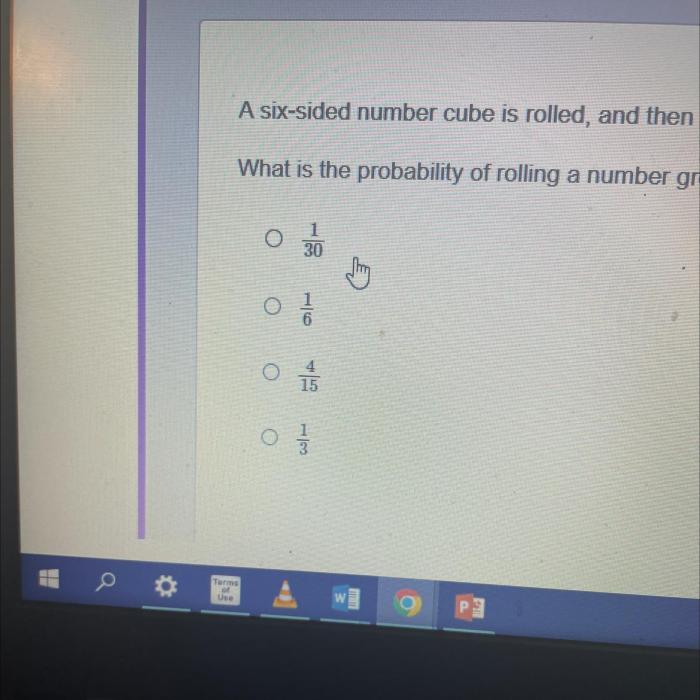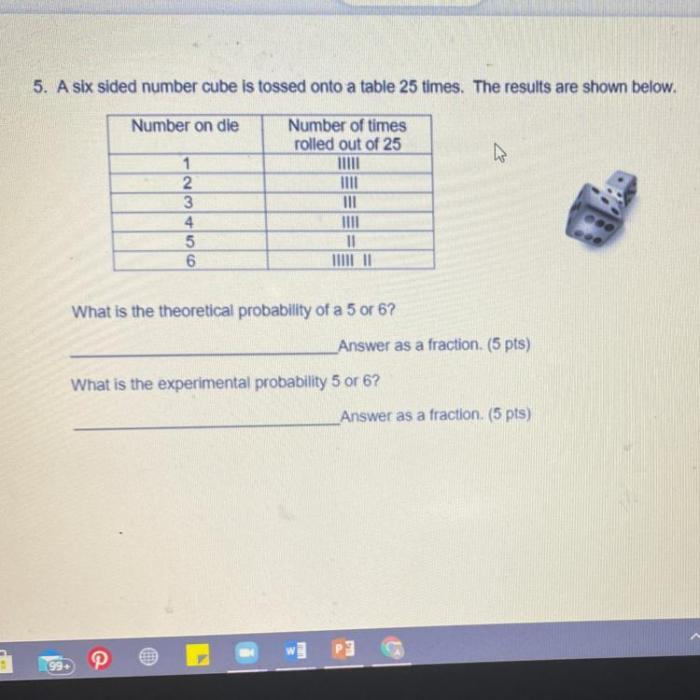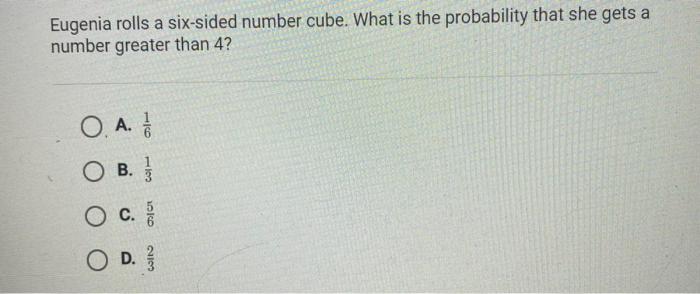A six sided number cube is rolled twice – Rolling a six-sided number cube twice introduces a realm of probability, combinations, and patterns that unveil the intricacies of chance and strategy. From the simple act of tossing two dice to the complex calculations of expected values, this exploration delves into the captivating world of randomness and its implications in games and beyond.
The probabilities of rolling specific numbers, the distribution of sums, and the myriad combinations that arise paint a vivid picture of the underlying mathematical principles. This journey through the possibilities of rolling a six-sided number cube twice promises insights into the fascinating interplay between chance and human ingenuity.
Probability of Rolling Specific Numbers: A Six Sided Number Cube Is Rolled Twice

When a six-sided number cube is rolled, each number has an equal chance of landing face up. The probability of rolling any particular number is therefore 1/6 or approximately 16.67%. This probability is constant regardless of the outcome of previous rolls.
The following table displays the probability of rolling each number on the cube:
| Number | Probability |
|---|---|
| 1 | 1/6 (16.67%) |
| 2 | 1/6 (16.67%) |
| 3 | 1/6 (16.67%) |
| 4 | 1/6 (16.67%) |
| 5 | 1/6 (16.67%) |
| 6 | 1/6 (16.67%) |
Sum of Rolled Numbers, A six sided number cube is rolled twice
When two six-sided number cubes are rolled, the sum of the numbers on the top faces can range from 2 to 12. The following table shows the possible sums and their probabilities:
| Sum | Probability |
|---|---|
| 2 | 1/36 (2.78%) |
| 3 | 2/36 (5.56%) |
| 4 | 3/36 (8.33%) |
| 5 | 4/36 (11.11%) |
| 6 | 5/36 (13.89%) |
| 7 | 6/36 (16.67%) |
| 8 | 5/36 (13.89%) |
| 9 | 4/36 (11.11%) |
| 10 | 3/36 (8.33%) |
| 11 | 2/36 (5.56%) |
| 12 | 1/36 (2.78%) |
The most likely sum is 7, which has a probability of 16.67%. The distribution of the sums is symmetrical, with the probabilities decreasing as the sum moves away from 7.
The expected value of the sum is 7. This means that if the cubes are rolled a large number of times, the average sum of the two numbers will be close to 7.
Combinations of Numbers
When two six-sided number cubes are rolled, there are 36 possible combinations of numbers. The following table lists all the possible combinations, organized by their sum:
| Sum | Combinations |
|---|---|
| 2 | (1, 1) |
| 3 | (1, 2), (2, 1) |
| 4 | (1, 3), (2, 2), (3, 1) |
| 5 | (1, 4), (2, 3), (3, 2), (4, 1) |
| 6 | (1, 5), (2, 4), (3, 3), (4, 2), (5, 1) |
| 7 | (1, 6), (2, 5), (3, 4), (4, 3), (5, 2), (6, 1) |
| 8 | (2, 6), (3, 5), (4, 4), (5, 3), (6, 2) |
| 9 | (3, 6), (4, 5), (5, 4), (6, 3) |
| 10 | (4, 6), (5, 5), (6, 4) |
| 11 | (5, 6), (6, 5) |
| 12 | (6, 6) |
Another way to approach this task is to list all the possible combinations in a single list, without organizing them by sum:
- (1, 1)
- (1, 2)
- (1, 3)
- (1, 4)
- (1, 5)
- (1, 6)
- (2, 1)
- (2, 2)
- (2, 3)
- (2, 4)
- (2, 5)
- (2, 6)
- (3, 1)
- (3, 2)
- (3, 3)
- (3, 4)
- (3, 5)
- (3, 6)
- (4, 1)
- (4, 2)
- (4, 3)
- (4, 4)
- (4, 5)
- (4, 6)
- (5, 1)
- (5, 2)
- (5, 3)
- (5, 4)
- (5, 5)
- (5, 6)
- (6, 1)
- (6, 2)
- (6, 3)
- (6, 4)
- (6, 5)
- (6, 6)
Applications in Games
Rolling a six-sided number cube is a common mechanic in a wide variety of games, both board games and dice games. Some examples include:
- Monopoly
- Yahtzee
- Backgammon
- Dungeons & Dragons
- Craps
In these games, the randomness of the dice roll adds an element of uncertainty and excitement. Players must use strategy and decision-making skills to navigate the game and overcome their opponents. The probability of rolling specific numbers and combinations of numbers can also be used to develop strategies and make informed decisions.
Detailed FAQs
What is the probability of rolling a sum of 7 when rolling two six-sided number cubes?
The probability is 1/6, as there are six possible combinations that result in a sum of 7: (1,6), (2,5), (3,4), (4,3), (5,2), and (6,1).
What is the expected value of the sum when rolling two six-sided number cubes?
The expected value is 7, as the sum of all possible outcomes (2 to 12) divided by the number of outcomes (11) is 7.


